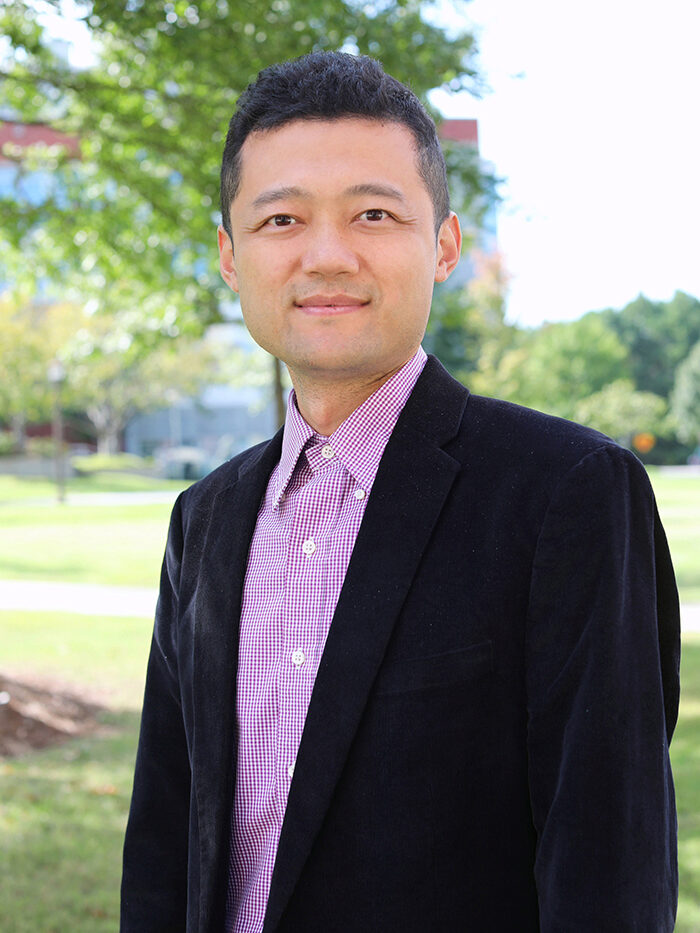Associate professor Tianye Niu joined the Woodruff School this fall and is still getting settled in as he adjusts to life on campus in the heart of Atlanta. In this Q&A he talks about his path to Atlanta, the motivations behind his research, and what drew him to Georgia Tech.
Where are you from and how did you end up at Georgia Tech?

I'm originally from China and I did my undergrad and Ph.D. at USTC Hefei. All of my degrees are in physics electronics. For the past ten years, I had been working at Georgia Tech, first as a postdoc and then as a Research Scientist I, and Zhejiang University at Hangzhou as a Research Professor. I started here at Georgia Tech this fall. When I worked as a postdoc at Georgia Tech, I felt this is a peaceful and supportive place to pursue my career and that is why I am here again.
Why did you choose a career in academia?
I chose a career in academia for two major reasons. The first one is the way of choosing interested scientific research. I am interested in the research topics combining fundamental sciences and real-world applications. These topics may have long-term impact on the society and may not be implemented within a short period of time. Academia provides the opportunity and patience to reach the goals. The second reason is the opportunity to meet the most talented minds and share my experiences with them. Students at Georgia Tech are very positive and creative when it comes to new knowledge and applications. It is very exciting to work with them everyday.
Who has influenced you in your career?
My research mentors, starting from my thesis during undergrad, my Ph.D.'s research advisor at USTC Hefei, my visiting advisor at U of Saskatchewan and then my Postdoc advisor at Georgia Tech. All these research advisors had an influence on my career.
What are you teaching this semester?
This semester there is no teaching requirement since I am just onboarding within the fall semester. Next spring I will teach MP/NRE 4750 - Diagnostic Imaging Physics. It's a required undergraduate and graduate class in MP/NRE program and it's on entry-level description of modern medical imaging methods. I plan to have a course project with the real data acquisition on one of the imaging modalities in my research lab.
What is your research area?
My research is in the area of medical imaging and image analysis, and specifically focusing on x-ray tomographic reconstruction and large-volume clinical data processing. It involves building software and hardware tools to perform the data acquisition and analysis.
Why did you get interested in this particular field?
I was always interested in making things applicable in the real world and help with the patient treatment. As an engineer, I was taught enormous techniques in class. When I visited the hospital, I found that new technologies are already appearing in clinical environments in a hysteretic phase. The translational study from bench to bedside is in urgent demand for the clinical applications. Meanwhile, huge amounts of medical data were buried in the hospital database. I think we do need to construct the bridge connecting the technology and clinical requirements.
So the goal is to scale up and bring these imaging technologies to the clinic?
Yes- to the clinic and to the end user, patient.
What research projects are you going to be working on here?
I would start two promising projects which have solid prior accumulation. The first one is an efficient and smart spectral CT imaging system design. Spectral CT is an advanced tomographic imaging modality with the capability of tissue material discrimination. Previous works on spectral CT usually apply complicated hardware to generate spectral photons. My new design abandoned these inconvenient operations and utilized an easy-to-make beam modulator to achieve the goal of spectral separation. The new scheme has the merits of high-speed data acquisition and low cost. It is extremely suitable for the dedicated CT systems including the conebeam CT in radiation therapy.
The second project is the inverse mathematical optimization of learning parameter selection for large volume medical image analysis. The conventional way of doing radiomics analysis is a trial-and-error process requiring tedious tuning on the parameters in the network. I am working on the automatic findings of the parameters using inverse optimization scheme based on the objective function in the analysis process. The new scheme is more robust and flexible to various situations in the data processing and can be implemented into the workflow of clinical applications.
How many students do you plan to have working in your lab?
At the initial stage, I prefer to have two students working on the projects. More students will be included when new results are coming out and new project are designed. I will mentor the students by leading them to understand the way of finding and solving problems themselves. In other words, the students are expected to be the leader of their project. To achieve this goal, I will put a lot of effort into discussing the project details and help them to come up with several potential solutions. In the discussion, I will help them to summarize the key points and write reports for their future publications.
What is the biggest challenge of being a new Professor on campus?
Well, organizing different responsibilities at the same time is the biggest challenge of being a new faculty. In the meetings with senior professors, I learned a lot about rules and policies of the school and I will keep learning from them.
